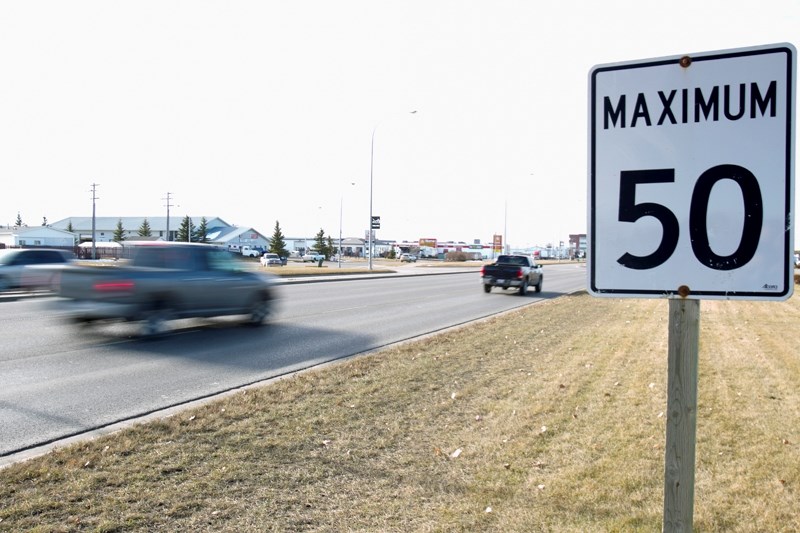The Town of Olds is hoping to get the 50-kilometre-per-hour speed limit in the northbound lane of Highway 2A near Olds High School extended about 300 metres farther south to the Olds cemetery.
Currently, there is an 80km/h sign on Highway 2A at the southern town boundary for northbound traffic and a 50 km/h sign 300 metres farther north. The 50 km/h sign is only 300 metres south of the highway's intersection with 57 Street.
By moving the 50 km/h speed limit sign further south, it would allow northbound traffic more time to decelerate from travelling 80 km/h before approaching the Community Learning Campus and encountering Olds High School students that may be crossing the highway at its intersection with 57 Street.
The issue was brought forward at the Oct. 28 meeting of town council after Olds-Didsbury-Three Hills MLA Bruce Rowe forwarded a letter he had received from provincial Transportation Minister Ric McIver to Norm McInnis, the town's chief administrative officer. The letter laid out the ministry's plan to change the speed transition zones along Highway 2A north and south of town and along Highway 27 east and west of town to provide consistency.
The proposal calls for a 300-metre transition zone between the 100 km/h and 50 km/h speed zones at each approach into town where the transition speed limit would be 80 km/h.
McIver's letter also included Alberta Transportation's proposal to increase the speed limit along Highway 27 between 57 and 70 avenues from 50 km/h to 60 km/h.
At the council meeting, McInnis said the current placement of the 50 km/h sign on Highway 2A is too close to the highway's intersection with 57 Street. He suggested that it should be moved a further 300 metres south to the town boundary at the Olds cemetery. Many councillors agreed.
“I agree we have to be stronger in our wording,” Coun. Mary Jane Harper said, adding Mountain View County's support should be sought for moving the speed zone. “We have concerns about buses, pedestrians and vehicles coming out of the (Community Learning Campus).”
McInnis said he likes uniform speed zones for all directions approaching the town. But he said the current 50 km/h zone in the northbound lane of Highway 2A starts too close to the CLC for his liking, noting that traffic often doesn't slow down until it gets to 54 Street, after it has passed the entrance to the CLC. He noted that town administrators were last in contact with the ministry in 2009 about the issue, just prior to the CLC opening in February 2010. At that time, town officials argued for moving the 50 km/h zone farther south, but were overruled by Alberta Transportation. McInnis said because the east side of Highway 2A south of the town's boundary is in Mountain View County, the town didn't have as much influence as administrators would have liked when the original discussions took place in 2009, so town officials will be soliciting county support as discussions move forward in the future.
“We certainly are in favour of having uniform transition zones coming into town,” he said in an interview following the meeting. “The only thing that we're going to be responding back to the minister of transportation through our MLA is that we think that the 50 zone on the south end of Highway 2A should be a little further back than it is now because basically (the transition zone) is right at 57 Street. If we could slow traffic down there I think it would be a better option for the community.”
Nancy Beasley-Hosker, a spokeswoman for Alberta Transportation, said as long as the town makes a request to the ministry to have the speed zone moved south, Alberta Transportation would consider it and make a decision based on traffic patterns. Beasley-Hosker said a 300-metre transition zone between speed limits is the standard, but that exceptions can be made to lengthen the transition zones in certain cases if circumstances warrant a longer transition.
“If the town would like that revisited, Alberta Transportation would take a look at it,” Beasley-Hosker said.
McInnis said he prefers that the transition zones in all four directions around the community be the same to promote consistency and avoid confusion.
“It's much less confusing and once people get that it goes from 100 (kilometres per hour) to 80 to 50 no matter where you're coming into town, I think the better off we'll be,” he said.




